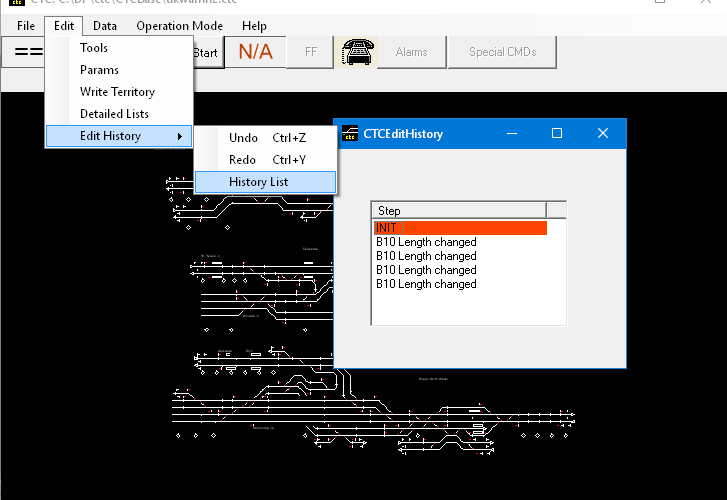To understand Undo/Redo you need to know that there is actually no Undo, only Reload and Redo.
Think of it as if the whole territory data is saved after every editing you do. If you need to go back, a previous safe-copy would be loaded.
Now, CTC does not automatically save the territory every time. Instead it maintains a log file recording all the editing affecting the territory data. When you do an Undo, CTC will reload the file from which you loaded the territory, or the last time you saved it to, and then execute the steps recorded in the log file up to the point as needed. A simple Redo is then just a one additional step forward in the list. You can Undo and Redo all the way back and forth (use <CRTL>+Z or CRTL>+Y, respectively), or you can select a step in the Edit History as shown below (the last edited step is highlighted there – the “INIT” line represents the state as the file is just loaded, the others contain a short description of each step being recorded).
If you edit your territory after some Undos, the rest of the edit history for potential Redos is eliminated, so you cannot go back and Redo another branch.
If for some reason the territory was not saved before leaving the program, and you start it again loading that file, CTC will look for the log file to see if there were any unsaved edits, and will display a message if there are – but will not do any redos (leading to a state as shown in the picture below)
Activities not leading to changes in the territory data will not be recorded, e.g. resizing the window, navigation on the screen, opening or closing other windows, or any drawings or markings you can do with various tools. The global pool of track elements will not be saved, neither a route list you have in a work area. Other windows that display some detailed data will be updated during undo or redo, but if an object does not exist anymore after undo or redo, a window showing details for this object will be closed. For technical reasons, group editing and filter windows will also be closed, and the selection list in the Detailed List window will be cleared.

<CRTL>+Z and CRTL>+Y are not only available in the main window, as shown here, but also if the Detailed List window is active.